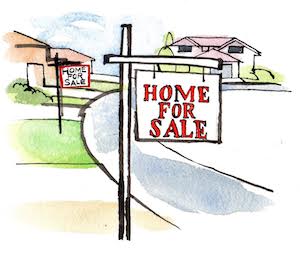Hubris was rampant among builders during the last boom. As with previous recessions in every decade since 1968, many builders were the last to see the 2008 crash coming. Mike Storey remembers it well. “We listened to analysts like Ivy call the last downturn,” he says, referring to Ivy Zelman of institutional investment research firm Zelman & Associates, “and we laughed at her because we were still raising prices by 30 grand.”
Storey recounts just how quickly the bottom dropped out of the Sarasota and Tampa markets in Florida, which in 2006 were so red hot that prospects were put on a waiting list before they could buy a home. At the time, he was working for Taylor Morrison, and says that houses didn’t become available until they went to drywall, and when the builder called, buyers had 48 hours to get to the office and sign a contract. When the market turned, those lists vaporized within two weeks.
“Consumers, in a lot of ways, were smarter than we were,” Storey says. “They saw the housing downturn before the builders did and acted very quickly. They stopped buying homes, started walking away from contracts, but builders were in denial. Pay attention to the consumer. They are smarter than us,” advises Storey, who is now president of Neal Communities, in Sarasota, Fla., ranked No. 45 on this year’s Housing Giants list.
The economic cycle for new-home construction is currently somewhere between the beginning of the recovery and the start of the next recession. Ask any builder or analyst what inning the industry is in and opinions vary widely from middle to late in the game, to “I don’t know.” There are those who see more legs in the current construction run, and who could blame them? Household formation is rising, unemployment is declining, and average mortgage interest rates are still near historic lows. Those conditions also existed in 2005.
That year, Mark Hodges, then an SVP with Hovnanian Enterprises, attended an industry conference in Pebble Beach, Calif., that featured a discussion panel about how long the building boom would last. The panel included a young economist from the UCLA Anderson Forecast who presented a contrarian view. He noted that the massive price appreciation in Los Angeles County real estate and elsewhere wasn’t sustainable, as potential buyers were being locked out due to affordability. This condition created mortgage consolidation shenanigans, with lenders competing over credit scores and “no doc” loans instead of interest rates. The party for home builders was about to end. That speaker, Christopher Thornberg, has since launched Beacon Economics, a growing economic analysis and forecasting business for municipalities, county governments, and corporations.
“I was sitting at a table with a lot of national home building leaders, and one of them leans over and says, ‘Kids, what do they know?’ Everyone laughed it off, disregarding a very salient warning,” says Hodges, who today is a strategic planning and quality management consultant for builders through Blueprint Strategic Consulting, in Haddonfield, N.J.
RELIABLE INDICATORS
Builders can have their pick of analysts for reading the tea leaves, but what else are they relying on to warn them of the market’s impending softness or to help them identify growth opportunities?
“You can figure out how forward-looking management is by asking what metrics they follow to spot trends,” says Boston based Robert Crowley, managing director of investment bank Moelis & Company. “What are you worried about when examining if the market is attractive to go into or whether to allocate more capital to a market?”
The Des Moines, Iowa, metro market is home to big employers such as Monsanto and John Deere and it includes Altoona, Grimes, Polk City, and Ankeny, which is one of the fastest growing towns in the state, with a low unemployment rate and a median household income above the national average. But the statistics that Seth Moulton, co-owner of Classic Builders in Ankeny, monitors pertain to existing home sales. Resale inventory in Des Moines has been declining for three years, and resale houses average less than 20 days on the market once they’re listed.
Three years ago, Classic (No. 126 on this year’s Giants list) presold as many as 80 percent of its homes, but as the resale supply tightened, the builder steadily increased inventory to 50 percent spec and 50 percent build-to-order by the end of last year. “We made that shift when we saw the supply of resale homes go down, knowing that there are still people moving to this area, and they need to buy something in the next 30 days,” Moulton says.
Should resale inventory move north of 1,600 units, Classic can back off on spec homes and focus on marketing floor plans that can be customized. Buyers for those products, particularly if they’re resale sellers, would be willing to wait longer for their build-to-order house, as their current property takes more time to sell. Inventory is deemed a leading indicator that Meritage Homes, in Scottsdale, Ariz., tracks in all of its markets and submarkets. The company’s market research team gathers and analyzes new-home supply, homes listed for sale on multiple listing services, and housing formation.
As we think about the cycle, I don’t think we’re mid or late,” says Phillippe Lord, EVP and COO of Meritage, ranked No. 9 on this year’s Housing Giants list. “It’s a unique cycle that is being driven by supply right now. Supply conditions are unprecedented for new-home and resale supply. There’ still quite a bit of room here just because of that.”
Even the weather can trigger a pattern of behavior for those who are alert. As the East Coast was getting pummeled during March with heavy snow and gale-force winds by a fourth nor’easter in less than three weeks, Steve Soriano, CFO at Robson Communities, contemplated from his office in the Arizona desert the storm’s impact on the spec inventory for his company.
Ninety-five percent of the Sun Lakes, Ariz.-based builder’s homes are presold to its core target of 55-plus buyers. But some of Robson’s business is seasonal, so the company, No. 67 in this year’s Housing Giants rankings, keeps 13 to 15 spec homes per community available at any given time. Managing that housing stock is as simple as starting to build the next home when one house is sold.
"If the Northeast has one more snowstorm, we’re going to sell an extra four or five houses that month,” Soriano says.
There is an observable, direct linear correlation between the weather back east and our sales. People don’t want to wait six months, or however long it takes, to build a production home, or longer to design a custom home. If snowbirds want a home sooner than that,” Soriano says, “we have product for them.”

FROM MICRO TO MACRO
Anticipating what the market will do is like trying to figure out where the hockey puck will go, but builders don’t have to just rely on a hunch. “There are potent metrics, both macro and local,” Hodges says, “that give reliable clues about the market and where it’s going, which should influence a builder’s strategy in the areas of land acquisition, spec building, and competitive market positioning, including sales pricing and incentive strategies.”
His list of statistics for gauging the market includes local indicators such as building permits pulled, standing inventory, spec starts, cancellation rates, and more macro demographic data including job creation, household formation, and migration patterns. There also are market measures that builders can source from local Realtor boards such as resale for-sale inventory, houses under contract, houses sold, average and median sales prices, and time on the market. Other signs are more like observed market intelligence.
That could be a seller’s take-it-or-leave-it market shifting to one where there’s more negotiating, incentives being offered, and sellers paying closing costs. When a prospect walks into a sales office looking to buy something within 90 days because they just sold their current home, that could indicate a strengthening market for spec homes. Each week Trendmaker Homes (a subsidiary of TRI Pointe Group, which is at No. 10 on this year’s list), gathers a qualitative read from the field by sending a sentiments survey to its two dozen new-home advisors in Houston. The brief questionnaire asks salespeople to respond with just a couple of sentences about what they’re seeing in the market regarding traffic, what buyers are looking for, and what Realtors are telling them. Job creation is an easy metric to watch, but digging deeper into what jobs are paying can yield more meaningful insight for directing a course of action.
For example, during 2011 to 2014, the benchmark price for crude oil hovered near $100 a barrel, until OPEC waged a price war against U.S. producers. Immediately after OPEC members failed to set production limits at a meeting in Vienna in November 2014, the barrel price plunged and ultimately dropped below $40. Joe Mandola, Trendmaker’s president, recalls tracking a “scary-looking” chart during the oil crash. One line on the graph representing the barrel price of West Texas Intermediate crude sloped diagonally down from left to right, crossing the company’s spec-house inventory line, which rose diagonally up forming a big, ugly X.
Drilling rigs shut down and oil and gas producers and related oil and gas service companies in Houston cut more than 90,000 high-paying jobs over the next two years. The manager level, high-salaried oil patch employee was Trendmaker Homes’ core buyer for its popular half-million dollar two-story home with five bedrooms, 4 baths, game room, and media room, all in 4,170 square feet. That buyer either was laid off or lost confidence in his or her job stability.
Trendmaker’s in-house architect and production group went to work and within two weeks pulled 182 square feet out of the popular plan, mostly by reducing the first-floor room sizes while keeping the room count the same—a minimum requirement for the Houston buyer. The smaller plan was construction documented within another two weeks; the framework prototyped in 12 weeks. In all, the redrafted model went from origination to completed house in 10 months. It was priced at $20,000 less, built in another community that hadn’t seen the more expensive version, and was favorably received by those buyers looking for cheaper housing during the oil crash. Trendmaker has since rolled out additional products to show to the growing pool of buyers searching for more affordable homes.
“Losing oil and gas jobs and gaining hospitality and teachers over time changes the complexion of the market,” Mandola says. “That swings you from selling executive homes to getting down to a more affordable price point. This market swung hard to where you needed to be at $350,000 and below, not at $500,000.”

AFFORDABILITY AS INDICATOR
“When affordability becomes a real problem, that usually suggests some softness in the market and things need to reset,” Lord says. Last year Meritage’s board of directors charged management with stress testing the builder’s balance sheet and working through hypothetical what-if scenarios to develop possible responses to market shifts by reducing cost, overhead, and land management.
“Our whole strategy around the entry-level buyer is being driven by the what-if scenarios,” Lord says. “We see affordability as something we need to be paying attention to right now. Home prices in Denver are the highest they’ve ever been. Northern California is back to peak levels, and Dallas is high. We started thinking about this two years ago and decided to buy more land for entry-level, smaller, cheaper lots that we can turn faster, and use more rolling options. We also went through a value engineering process with product all across the company to see where we can take out waste, reduce our costs, and get more price-sensitive.”
LEVERAGING SALES INTELLIGENCE
One source of market intelligence that’s more abundant since the housing market crash is internet data. Online sales staff can be a builder’s canary in the coal mine because they feel market shifts first. When Kevin Oakley was director of marketing for Heartland Homes starting in 2008, more than half of the Pittsburgh builder’s marketing budget was switched to online outreach. The sales staff of three tracked organic website and social media traffic, inbound leads from the web and phone, and conversion of leads to appointments. Those numbers started dropping well before traffic to model homes declined.
“If the metrics you’re watching are in the model home, you have a much narrower window to adjust and see what’s coming, whereas if your online inquiries and requests for information are dropping off, that will happen much sooner and will give you more time to adjust than just 30 or 45 days,” says Oakley, now a managing partner at online sales consulting firm Do You Convert, based in Columbus, Ohio. Heartland quickly repackaged its homes by lowering the base price while holding the line on incentives and discounts. While other builders in Allegheny County struggled to survive the Great Recession, Heartland grew by 20 percent each year from 2008 to 2012, from approximately 200 closings to more than 450.
The sales team also spotted the recovery coming in 2012, as the online metrics showed that traffic was gaining. So the builder adjusted base prices and marketing outreach accordingly to catch the rising tide of buyers. “We wouldn’t have seen that show up in a model home for another month or two,” Oakley says, adding that model-home traffic for any builder will likely decline year to year as more buyers start their home search online.
Constant communication with the sales team is the leading source of market intelligence for Neal Communities. The conversation isn’t so much about why the buyer didn’t make a decision today as it is about asking, What is the buyer thinking? With more data being collected from prospects through presale marketing, Storey says Neal Communities is better engaged with consumer sentiment than it previously had been.
“When we look at what is the cycle of their first contact with us to their buying decision, if we see that time lengthening, that indicates buyers are uncomfortable with the current environment,” Storey says, “and you have to pay attention to that.”
Meritage invested in customer relationship management in 2011 by implementing the Salesforce CRM system. Answers to discovery questions that salespeople ask prospects about what they’re looking for and why they’re looking are regularly loaded into the system, along with data about website traffic, demographics, and tons of other digital information. Meritage currently is rolling out its second version of the CRM.
“It’s almost like artificial intelligence,” Lord says. “We’re able to see what people are doing when they click on our website and where those leads are coming from. You can start to create algorithms that suggest what leads are qualified and which ones are unqualified. If we are consistent with collecting and inputting information, we can see patterns that tell us who is likely to buy and who is less likely to buy.”
DOWNTURN STRATEGIES
Perhaps being nimble is really a product of having proactively made adjustments in prior years when managers would identify a key apparatus or function the organization needed. Mandola credits Trendmaker’s ability to build homes at lower price points during the oil crisis to already having an in-house architect and developing the capability for converting raw land into finished lots within 24 months.
Agility for Robson Communities isn’t being able to roll out cheaper product during a slump. The luxury retirement communities targeting 55-plus buyers are so front-end loaded with resort amenities and infrastructure that selling a low-end product wouldn’t allow the developer/builder to recoup that cost. Rather, Robson hired more sales management staff and reps to provide the consistent experience that’s important to buyers. Robson offers dozens of house plans catering to the needs and desires of Baby Boomers. “We incorporated an in-house architecture department, which allows us to create a lot of floor plans, meeting new customer desires much faster,” Soriano says. “We can go from concept to field model in less than six months.”
Some companies, such as Neal Communities, are comfortable with being reactive. The builder/developer has a core group of employees with at least 15 years of tenure and experience riding out tough times, as well as a reputable brand that targets recession-proof early retirees/empty nesters. Neal is looking at better serving 24-to-44-year-old buyers but that effort has more to do with growing the business with a key demographic than it does with preparing for the next recession.
“I think when you act like you’re trying to predict when the next downturn will be, you actually take a risk in doing that,” Storey says. “If I plan for a recession in summer 2020 and the downturn doesn’t happen until 2025, I missed an opportunity for those five years that I planned on dealing with the recession. We focus on being nimble and being able to react to a downturn.”
Storey says he thinks owner and chairman Pat Neal did that better than anybody. When the market tanked in 2007, Neal Communities took a moribund $550,000 townhouse plan in the Forest Creek community and within six months went from concept to permit applications for three smaller cottages with prices starting at $120,000. It gave the company momentum.
“Every day builders are closing homes, receiving cash, and making decisions about what to do with that cash,” says Moelis’ Crowley. “They can’t wave a magic wand and reposition their business overnight, but every day they’re making decisions on where to invest new dollars in terms of land deals or whether or not to build spec homes. If they spot trends that are giving them warning signs, I think they’ll reallocate dollars. If the signs are particularly troublesome, they’ll just start conserving cash.”
One exercise that business consultant Doug Wilson of Next Solutions does with his home builder clients is to work out how they would prepare for a market slump. “If you knew that in two years a 40 percent downturn is definitely coming, what would be your response?” he asks. “I find that to be a good strategy to think through. Layoffs would probably be the first thing you do. Second, what would you do with the land? All of the land you were going to build on for a year figuring you would sell two houses a week: Now your lot inventory has been extended to two years because you’re selling one house a week. What does that mean for your cash management? People don’t think about those things. They’re too optimistic about making money, and they lose track.”
When a slump threatens to maroon spec inventory, better for the builder to be the pricing leader than the follower.
“You have two choices when the market is on the way down,” Hodges says. “You either lead the market down by lowering your prices first in order to absorb whatever buyers are in the marketplace and at least get some margin, some traffic, and some sales out of it, or you do what most builders do and just follow the market down. Builders that follow the market give up margin,” Hodges says, “but they don’t get any sales velocity because what buyers were out there get absorbed by the guy who beat them to the price reductions.”
Being the first to act contrarily when you suspect the market will change is a tough decision. What may be more palatable than a blanket move affecting an entire community is acting tactically on a house-by-house basis. Take one house in a community and value price it to an acceptable margin and hold firm on the pricing for the other homes.
“We did a lot of Showcase Home of the Week, blasted out to Realtors that this is the new price, and called everyone on our lead list,” Trendmaker’s Mandola says. “When we moved that one, we rolled out another one. Sometimes we got people who came to look at the value-priced home and bought another house. We’re just trying to drive traffic qualified to buy a house.”
Prototyping to a cheaper home with fewer standard features was already mentioned as a downturn strategy. Conversely, in a hot market, builders should move up to products that will make more money. A Raleigh, N.C., client of Oakley’s was struggling to keep up with demand for its smallest house plan, which was earning a $50,000 profit. Oakley coached the builder to mothball that house and instead build the next bigger model that would generate $60,000. Oakley recalls encouraging his client to refrain from offering the less-expensive plan. “When the market is hot, you want the most profit per transaction,” Oakley says. Should the market slow, the builder can bring back the mothballed plan and have something to show buyers who are shopping online and filtering their search results with a low price point.
One tactic Hodges recommends is to work harder to convert prospects. If the monthly conversion rate for a community is three a month out of 100 prospects, find a way to get just one more sale per month (converting one more prospect out of 97 visitors) or 12 additional sales for the year. “When every single sale is hard to come by, working harder to convert that rare good prospect is all the more important,” Hodges says. Oakley adds that builders should cut out any advertising spend that doesn’t produce trackable results.
“If something can’t justify continued investment on its own with hard facts, stop doing it so you can max out the area producing a quantifiable return,” he advises.
If a slump is prolonged, Oakley recommends shrinking the sales staff and keeping the best sales reps in an effort to maintain a higher lead volume and conversion rate per salesperson. He explains it this way: Assume your business split 200 leads per month between 20 reps when the market was robust. That would work out to 10 leads per rep, and if 10 percent of those leads converted to sales, you sold 20 houses a month. But if the market slows and you’re getting 75 leads, keep your five best salespeople. Their workload is now 15 leads per person and if, because they are better, they convert 15 percent of leads to sales, they’re producing 11 sales per month compared with just seven if you’d kept everyone onboard with the 10 percent conversion rate. “That’s better than padding the staff for the small amount of walk-in traffic that’s actually happening,” Oakley says.

LAND POSITION
Land management is a long-term strategy and inherently is not nimble considering that in some jurisdictions getting permits and entitlements could take as long as three years or more. When builders see land and spec inventory rising, they may want to review their land takedown schedule and consider spreading out their acquisitions and offering to pay the developer more to extend the takedowns. “The land seller may kick and scream, but they are worse off if you walk away from the deal rather than if you spread it out for a while,” Hodges says.
When Meritage was hit with the oil crisis in Houston, the builder simply stopped buying land in the Bayou City. Since the onset of the last recession, Meritage diversified how it buys land and expanded from being merely a builder of move-up houses in Arizona and Texas to a company with a coast-to-coast presence taking on infill, entry-level, and townhouses as well. Meritage also beefed up its capability to self-develop and entitle raw land. It only occasionally buys retail lots. The Texas oil crash arrived faster than a plodding recession, so a glut of spec housing developed almost in an instant, and housing starts ceased. Trendmaker approached its third-party land developers to push takedowns to the next quarter and rework terms and price.
“That is where being a strong brand and being in the market for 47 years matters,” Mandola says. “We have a lot of good relations, so when you go back to those developers for an extension, they get it. They know you wouldn’t be doing it if you didn’t need to, and we’re there to partner with them in good times and bad. They know we’ll pick up the slack in the rope when we can.”
The Houston builder has since expanded into Austin and diversified product with a master planned community of one-story home plans called The Villas, which targets empty nesters. Townhomes, other multifamily, and infill are other avenues Trendmaker could enter if the market provides the right opportunity.
“We’ve seen this movie once before,” Mandola says about the possibility of another downturn. “That doesn’t mean we’re arrogant. The market will teach you something new every day.” You’re never as smart as a good market says you are," he notes. “We know that and try to stay humble and see what the tea leaves are telling us and try to go that way. It’s kind of the fun of the business to figure it out, move forward, and be successful.”
Read the other articles in the 2018 Housing Giants Report
Advertisement
Related Stories
Housing Giants
The 2024 Housing Giants Survey Is Now Open!
Complete the 2024 Housing Giants Survey to see if your company makes the cut in Pro Builder's rankings of the largest home building companies in the country
Housing Giants
Builder Rankings by Revenue: 2023 Housing Giants List
Pro Builder's annual Housing Giants rankings list provides a snapshot in time of builders’ perceived opportunities and challenges. These are the top 240 home builders in the nation, ranked by revenue
Housing Giants
Holding Back the Headwinds
Stormy market conditions strained the nation’s largest home builders in 2022, and they’re bracing for more uncertainty









